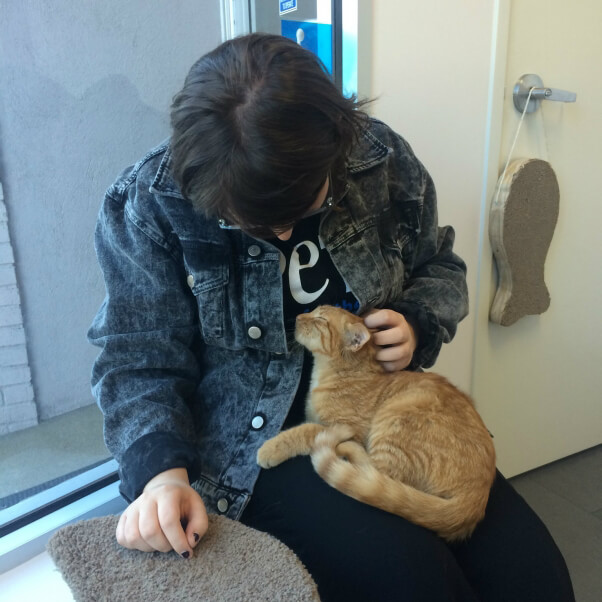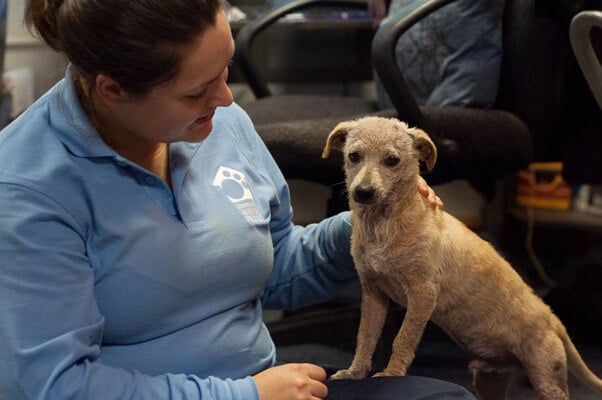6 Ways Your Class Can Help Homeless Animals
No matter what age your students are, learning that there are an estimated 70 million homeless dogs and cats struggling to survive and facing untimely deaths in the United States on any given day (and how the suffering and deaths of these homeless animals is 100% preventable through spaying and neutering) can lead students to make lifesaving decisions in the future. Whether it’s talking to their parents about supporting socially-conscious, open-admission animal shelters (and never buying any animal from a pet store or breeder) or volunteering to walk, groom, or play with a lonely dog or cat, every student can be a hero for animals who are still waiting for a permanent home.

Teaching kids why they should care about others and make kinder choices to reduce suffering is an invaluable lesson that can help your students realize their place in your community and our world. Empower them with these fun activities:
Make (and Deliver) Gifts
What can you make with pieces of old fabric, catnip, and yarn? Catnip toys that cats adore! You probably already have most of these items in your spare closet or junk drawer at home, and you can pick up catnip on the cheap online or at your local pet-supply store (just avoid Petco, PetSmart, and any other store that sells live animals).

DIY dog treats are also easy to make and can help students learn math, measuring, and home economics skills. Have your class whip up some heart-shaped doggy biscuits with an inexpensive cookie cutter (you can find them at any craft store). We love these three-ingredient treats.
There are also many DIY dog toys that are a snap to make—like these braided toys made of old T-shirts. The best part? Dogs in animal shelters will be grateful for every single second of work, and they’ll show it!

When you’re done DIY-ing it up in class, deliver the treats or toys yourself or do it as a class—and be sure to snap lots of photos of the animals as they enjoy the goods. Post the photos in the classroom to keep your students thinking about what they’ve done to make the world a kinder place.
Tell Your City to Make a BIG Change
Have high school students who are eager to make a difference for animals? The most effective way to help homeless animals is to prevent them—and asking your city to enact a mandatory spay and neuter law is a great way to do that.
Explain the importance of spaying and neutering, check out the current legislation in your area, and work with your students to draft letters to local decisionmakers. Here’s an easy guide to working on lifesaving legislation.
Need more guidance? TeachKind is here to help! Just e-mail us at [email protected].
Hold a Blanket Drive
These are popular around the holidays, but shouldn’t every day be a day of giving? Your students can play Santa any day of the year by providing vulnerable animals with warmth and comfort. The world can always use a little more of those. And this activity is really easy—all you need is a box. Then have your students ask their parents for old T-shirts, blankets, or towels to donate to your local open-admission animal shelter (a shelter that accepts every animal and never turns animals away for lack of space).
Be sure to lead by example by donating a few old things of your own to get started.

Take a Field Trip
After using TeachKind’s lesson plans focusing on adopting and never buying companion animals as well as the importance of taking proper care of them, contact your local open-admission shelter and try to set up a trip for your students to visit it.
This may seem like a sad lesson, but it’s an important one. Seeing the animals firsthand can make a lifelong impression on your students. When their family decides to add a new cat or dog or when they graduate from college and get their first apartment, they’ll think about the animals they saw in the shelter and be more likely to make the compassionate choice and adopt a homeless cat or dog instead of buying one from a pet store or breeder.
This is one school lesson that can truly save lives.

Host an Animal Shelter Worker
Most kids care about animals—and they want to help them. We bet you have more than one student who wants to be a veterinarian or a marine biologist, and teaching them how to help animals in their own community is a great first step.
Shelter workers do more than just play with cute dogs and cats—they work on socializing animals who come from abusive situations, counsel guardians on how to take better care of their companions, screen potential adopters, coordinate fundraisers, and more. Younger students will love hearing about how to be better friends to cats, dogs, and other animals, and older students can learn about the importance of cruelty case investigations, humane laws, open-door policies, spaying and neutering, and more.

Extra Credit
Work with your local animal shelter to get your students trained to volunteer (each shelter has different requirements, so be sure to check in advance), and then offer students extra credit for volunteering throughout the school year. Giving awards such as “Hero for Homeless Cats” or “I’m a Dog’s Best Friend” is a great incentive, too, and can get your kids excited to make a difference.






